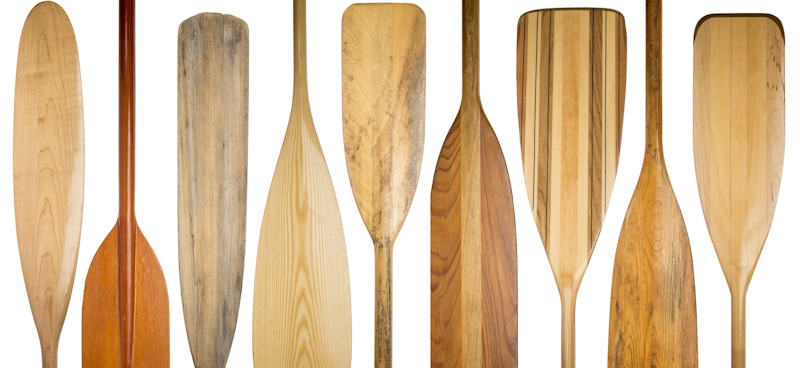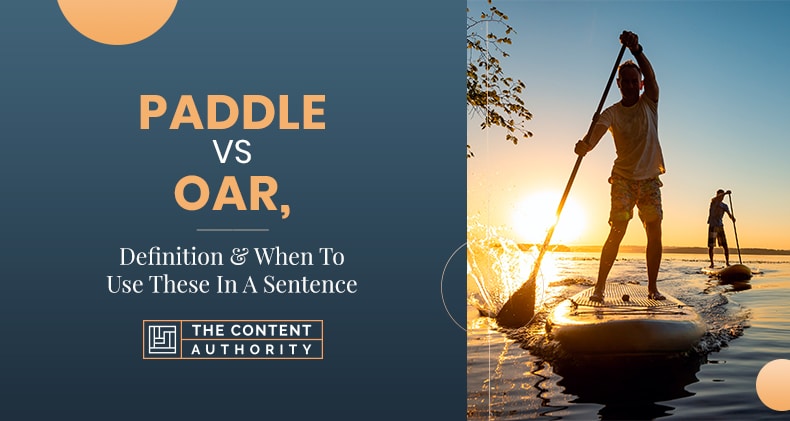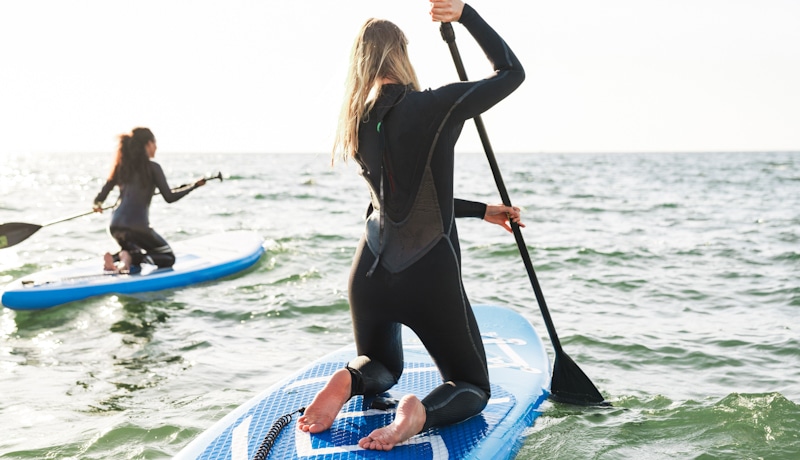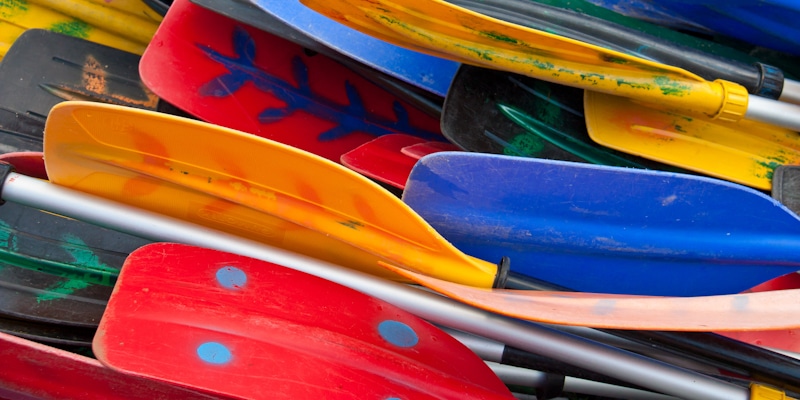Do you like to surf, sail or do water sports? Do you want to go out to the sea to catch waves or take a stroll enjoying the scenery? Surely you have heard many acquaintances or friends use the words paddle and oar as if they were synonyms. But the truth is that they are not the same, nor are they used for the same sport.
Oars are paddles used to propel you and your boat through the water. But unlike the paddle, they are attached to the kayak. The paddle has one or two blades that are not part of the boat. Its handling and stability depend solely on the person who is practicing the activity.
Would you like to know more about these water activities that could be an ideal hobby to have a good time during your leisure time? You certainly have heard people who practice this kind of hobby or sports use the words paddle and oar. This article will explain the basics of these two terms, their differences, and their uses.

The Origin Of Oars And Paddles
These necessary navigation accessories have many centuries of existence in people’s lives. Throughout time we have been able to see their evolution in design and function. However, they have always held a preferential place in the maritime, sport, and recreational world. So let’s review the history of these accessories.
The Origin Of The Oars
The use of oars has been familiar to us since the beginning of the Neolithic period. For example, at a site of the Hemudu culture in Yuyao, Zhejiang, wooden oars dating back to 4500-5000 BC were used in modern China. In 1999, a group of archeologists unearthed a paddle with 63.4 cm in Ishikawa, Japan, dating back to 4000 BC.
The Origin Of Paddles
In the ancient world, people of the time used to reinforce their paddles with bronze. These paddles were not only used for sailing but also to decorate their boats.
In the Middle Ages and up to the 17th century, an intelligent technique was used to balance the paddles. Paddles were anchored with lead weights at one end to suspend the part of the paddle outside the boat. The men, which varied from three to seven, were responsible for handling the paddles.
The length of the paddle changed depending on the type of boat. For example, it could be 11 meters long for the outer part and 7.7 meters for the inner part.
The Origin Of Paddle Surfing
As we can deduce from its name, paddle surfing is a sport that originated from the traditional paddle.
Much like many other sports, this sub-specialty was born in the United States. Experts can trace paddle surfing back to the ’60s in Waikiki Beach, Hawaii. Then, the surf instructors began to use longer and more stable boards to take panoramic pictures of the landscape on this beach.
They started using paddles in canoes to follow their students closely and to be able to correct their paddling technique. They could also anticipate dangers or upcoming waves. However, it wasn’t until the beginning of the 21st century that some famous Hawaiian surfers began to use paddles as part of the training of their students and thus bring their training to a satisfactory finish.
Main Differences Between Oars And Paddles
We may hear some people use the two terms in the same way. However, the reality is that they are not the same and have particular characteristics that differentiate them.
What Is An Oar?
People use oars to propel or move the boats. The oar is attached to the ship; this means that it is part of it. The oar slides through a ring that helps it to be released and lost at sea.
Boats propelled only by oars and large ships with sails can both be propelled with oars. The oars were the ones that moved the Viking ships of the 8th century in the Iron Age. They even say that Viking could mean oarsmen, or translate as “men who row in turn.”
What Is A Paddle?
You can find paddles with one or two blades. Double-bladed paddles are typically helpful in kayaks, and single-bladed paddles are useful in canoes or larger boats.
Unlike oars, the paddle must be kept with you at all times or secured in some way. These security actions prevent the paddle from falling into the sea when not in use. You can use paddles on rafts, stand-up paddles, or inflatables.
Some Differences Between Oars And Paddles
Let’s review some of the main differences between oars and paddles.
- Oars are used only for paddling.
- The oar is connected to the boat by a pivot or ring, designed for this purpose.
- The oar is on its pivot with the short end inside the boat and the long end outside. The paddler grips the sharp end, and the long end is in the water.
- The paddler holds the paddles with both hands.
- The paddles are not part of the boat.
- The direction the boat takes is different depending on if you are using oars or paddles.
- When using oars, the paddler sits with his back to the front of the destination point.
- There are boats designed to use oars, where the paddler’s seat moves back and forth to help the paddler paddle more easily. These seats allow you to use the strength of your arms and legs, which will facilitate the act of paddling.
- When using a paddle, the paddler is always facing forward.
- With kayaks, a double-bladed paddle is the most common choice.
- With canoes, you can use a single-bladed paddle. This type of paddle will require a different paddling technique.
The Materials Of Manufacture
It is a common fact that you can find oars and paddles made from different materials. In general, oars are made of hardwood, although sometimes we can find some made of carbon fiber. These types of oars are used in high competition sports and paddle teams worldwide. However, we will see wooden oars in everything else.
On the other hand, the primary materials used for paddles are carbon fiber, aluminum, or fiberglass. These materials make the paddle long-lasting.
The Use Of Oars And Paddles
Commonly both terms are associated with water sports and physical exercise. All of these uses provide a solid basis for why people are interested in these exciting hobbies.
When using oars, we have to use a large part of our body to paddle. When we paddle, we use our arms, back, and legs. If we have a modern boat, we may have a seat that slides to help us operate our leg momentum to power the strokes. This movement is very similar to rowing machines in gyms. There is no doubt we can all agree on the completeness of this exercise.
Paddling is also an excellent exercise, but it has a lower intensity. For this reason, paddleboarding is ideal for those who are just starting this activity. The reason kayaks and paddleboards are easier to use is that they move through the water more quickly than boats with oars.
Examples Of The Terms Oars And Paddles In Everyday Sentences
We will conclude this tour of water sports by examining some examples of the usage of oars and paddles in sentences.
- It is best to wear sandals when paddleboarding.
- This zone is the best paddle-boarding area on the island.
- When we each took an oar, we won the competition.
- This weekend we are going for a ride on Mike’s oar boat.
A Final Thought On Oars And Paddles
After this exciting voyage, we hope we have been able to clarify the significant differences between oars and paddles. Remember that depending on the activity you are going to do; it will be convenient to use paddles or oars. Additionally, remember that if you are facing backward when you are paddling, you are using oars. In contrast, if you are facing forward, you are most likely using paddles.
Shawn Manaher is the founder and CEO of The Content Authority. He’s one part content manager, one part writing ninja organizer, and two parts leader of top content creators. You don’t even want to know what he calls pancakes.



